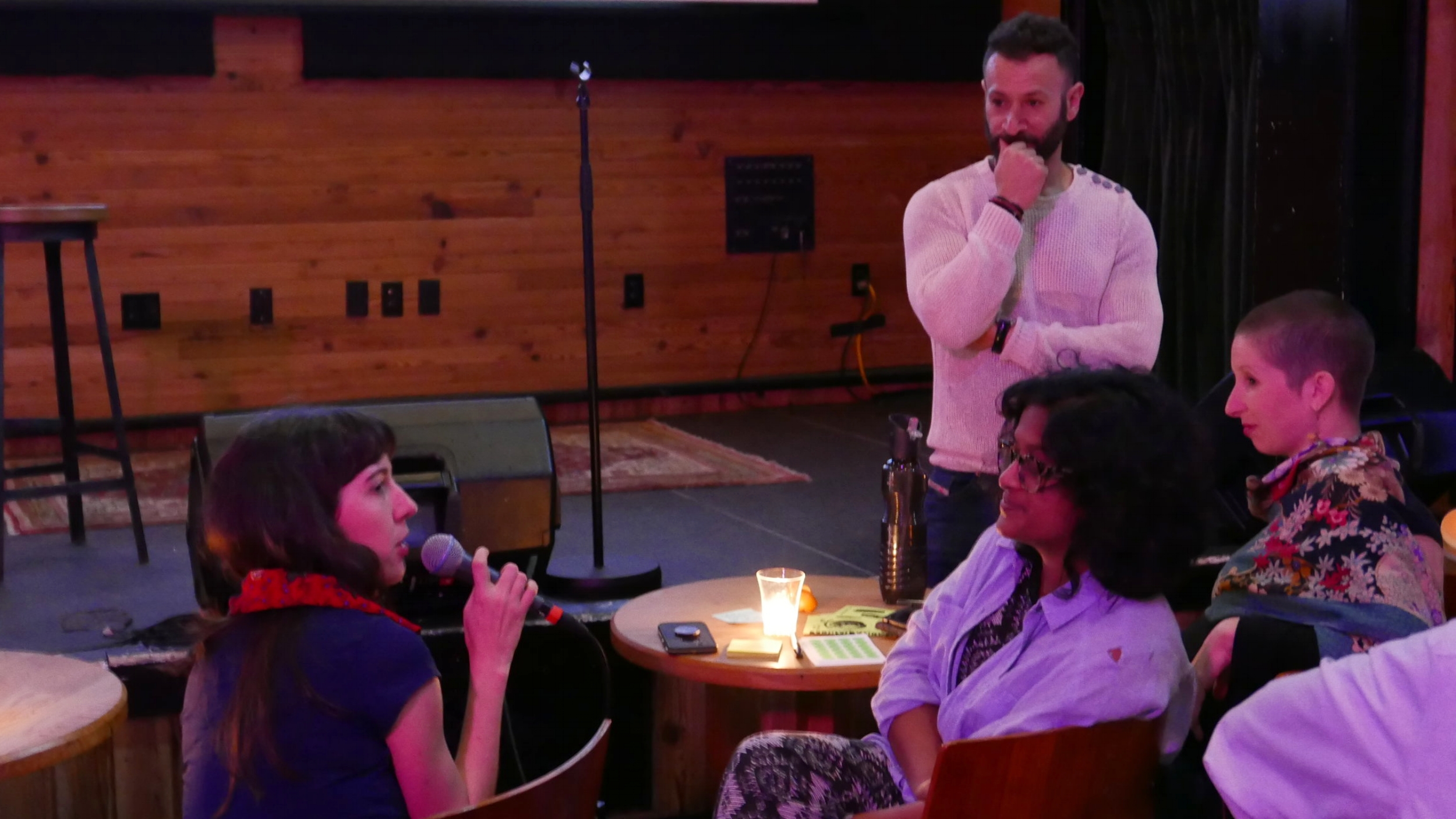On The Road in New Orleans with Ace Hotels
“I’m not sure but I’m almost positive that all music came from New Orleans.”
- Ernie K-Doe: The R&B Emperor of New Orleans
Open Music hosted its first public event on February 27 in New Orleans, in partnership with Ace Hotels. Artists, entrepreneurs, and curious fans were joined by Open Music’s Panos Panay and George Howard, as well as Peter Guglielmino, IBM’s Media & Entertainment CTO. Open Music members have previously met to focus on cross-industry negotiations, interoperability and API’s, but this was the first time that Open Music held an event focused directly on artists and the creative community, keeping music and artistry at the center.
So, assuming Ernie K-Doe’s quote is a true attribution to New Orlean as the birthplace of music, then New Orleans seemed a fitting place to kick off this first public event.
Ace Hotel’s Head of Business Development Greg Bresnitz kicked off the night, welcoming the crowd and answering the question, “Why does a hotel care about blockchain and music, and what does Ace Hotel have to do with Open Music?” Bresnitz explained that Ace Hotels values artists and communities, and encouraged the crowd to look at new technologies such as blockchain as “malleable, and to imagine how new technologies can help artists: help artists to secure their creative rights, and to help them build and sustain a creative career.”
So in the intimate Three Keys venue, music students from nearby Loyola, artists spanning generations and genres, civic leaders, artist advocates, plus creative entrepreneurs, some of whom had flown in from as far as Pittsburgh and New York, gathered at candlelit tables and dug into the work and promise of Open Music.
Their reasons for attending were as varied as the ways they each create and perform music:
I’m interested in how tech can encourage people to collaborate and make music in experimental new ways.
I am really excited to see how the blockchain will come into effect and connect buyers directly to sellers, got some serious doubts about the current system.
I would like to gain exposure by connecting with others: exposure and interest is much more of a commodity than whether they will buy a tune or not.
I would like to focus on making copyright more accessible.
I’m interested in methods of collecting copyright holder information.
It would be nice to make everything simpler. That’s basically what technology is nowadays, just trying to streamline things.
For all their differences in style and background, everyone attended because they share a common belief in the power of art. As George Howard said that evening, “Why are we here? We’re here because, in essence, we believe that art is important, right? We tried everything else. We don’t have anything else left. So, maybe art actually has a chance.”
The evening was divided into three portions: Learn, Demo, and Engage.
LEARN
Co-Founder Panos Panay first introduced Open Music via a brief history of music creation, consumption and monetization, from player pianos to Apple watches, outlining challenges in rights management and payment streams, and telling the story of how and why Open Music was born.
After making a case for open standards and interoperability, he passed the mic to George Howard. George built on Panos’s presentation by speaking directly to the artists with a sense of urgency about why artists must know their rights as a songwriter, composer or performer, and how blockchain might restore financial value to the intellectual property that artists create. George then illustrated how blockchain’s key attributes are particularly applicable to music creators and creative rights holders.
Blockchain is decentralized.
It removes power held by a few. By decentralizing who holds the data, the control and power are thus decentralized in turn.
It allows for expansion of value because artists can price their work based on how much consumers will pay.
Blockchain is immutable.
All changes are recorded on a shared ledger, and changes must go through a verification process to verify that the changes are valid.
Anyone can see the change logs.
Blockchain uses smart contracts.
It allows artists the ability to have their music used in new ways by setting certain use-parameters that can be programmed onto the music.
It enables artists to expand out from tiny verticals and let more people discover and use their music.
Ultimately, George described the removal of power-asymmetries as akin to the past eras of grassroots-fueled musical innovation, such as the hip hop movement of the 1970’s. “Like Grandmaster Flash in the 70’s, who created something from nothing, and empowered communities to reclaim their voice, we’ve now been handed a new tool, to connect directly with our fans, and there are no intermediaries, because we don’t need them. Create sustainable careers on your own terms. It’s up to us to convince them that music is worth it.”
George left the crowd with the following call to action:
Understand publishing & know your rights.
Don’t wait for someone to find you: Make your music available to the public to be used in applications or services, in a machine-readable and licenseable way that dictates usage and prices.
Have a bias toward tech: Connect, join or start your own startups that starts pulling from the music, in the same way that airfare flights can be searched, and let price reflect demand.
Before the floor was opened up for demos and audience Q&A, Peter Guglielmino, IBM’s CTO of Media and Entertainment, addressed the crowd, first answering “what the heck is a guy from IBM doing talking to musicians”. Peter shared his own story as a musician, with a home-studio decked out with equipment he salvaged from the Brill Building studio when they closed their doors. Through his home studio, Peter met and worked with many local, talented musicians, most of whom have had full lives as musicians, and have little to show for it financially.
Peter’s personal passion had a clear intersection with his work at IBM researching technologies such as Blockchain that allow people to own their data, and to own a copy of the ledger where that data is recorded.
He described IBM’s hyperledger project as “working to make sure that there are multiple ways to get data onto a ledger through multiple models of passing consensus. The end purpose is to put you in control. Keep control of your data. If you can control your data, then you can control how you give up that data, and what you get in return for your data. And maybe your data is your music. In this case it is.”
Peter continued into technical details that were incredibly relevant for musicians and composers. “Where there’s mystery there’s margin,” he said. “You can use blockchain to help provide transparency, because you have a documented, auditable, immutable ledger, and you have code that executes the same regardless of what node it’s on, and you have data that is consistent across all those nodes, then you can equitably dispense the monies across the supply chain without people taking it who shouldn’t, or taking a greater value than they actually deserve. And that’s what we’re trying to do with blockchain, in case you wanted to know what IBM is doing.”
DEMO
The audience had absorbed an in depth look at music industry history, inner workings, and the future of tracking ownership and identity. It was time to see what this all meant to a full-time musician. Two Berklee students who had participated in the 2017 Open Music Summer Lab, Jonathan Koh and Tony Tirador, joined the event to showcase their project, LÜM.
They demoed a mobile device app, LÜM, that tracks various audience physical activity while at the club (e.g. dancing vs chilling at the bar), while simultaneously capturing which songs were played, and audience reaction. This aggregate data is then available to the DJ, as well as the songs’ artists and composers, and even potentially labels or club owners. Their demo illustrated how interoperability might enable dj’s, music creators, audiences, and even labels and rights holders to have greater opportunities for collaboration, and for receiving and analysing usage data of specific songs.
They shared how various stakeholders can see when the audience was more or less energized, how artists get a real record of where and when their songs are being played, and how DJ’s can even utilize the mobile device feedback from users to control visualizations in real time, play samples or modify the way the music plays during the DJ set.
While LÜM is currently not available for mass consumption, and the interoperability hasn’t been fully deployed on a blockchain, many in the audience understood its impact, and were interested in how they might get their hands on it themselves. The demo might have elicited more questions than answers, but it was clear that a technology with that potential could certainly be useful. The demo exemplified how an expanding industry could share prosperity with more people, and unlock new ways of enjoying, creating, consuming and interacting with music.
ENGAGE
After a program full of depth and breadth, covering multiple complex concepts, the audience was still attentive, and hungry for even more. They dove in with insightful questions and observations. The conversation ranged from how individual artists can engage in Open Music’s work, what new creative possibilities and opportunities can open up by this new way of tracking rights and attribution, and the technical solutions that might emerge as a result of new opportunities.
The audience also pointed to the need for equal access for all artists, including those still left behind by the digital divide. New Orleans was a fitting place to highlight this, not only as the cradle of “all music”, but certainly as one of the cradles of black musical traditions upon which the 20th century music industry was built.
While it’s possible that many left with more questions than answers, they also left newly energized. And, if nothing else, know now which questions to ask. Using easel paper and a sharpie, Howard outlined the basics of a Net Promoter Score, and gesturing to the eager crowd, highlighted that Open Music’s NPS was growing, and that “Something is happening.”
We agree. Something IS happening. After 2 years of convening the industry, encouraging interoperability, and building a solution, Open Music is now kicking the tires, taking its technology out on the road, and bringing demos back to artists and creative communities to educate and get additional feedback. There’s been considerable behind-the-scenes work, but we couldn’t be more excited to get out on the road, share what we’ve made so far, and hear what you all think and need. Want to get involved? Show up, reach out, and start testing it yourself!



